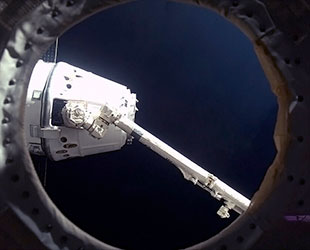March 3, 2013 — A commercial cargo spacecraft pulled up alongside the International Space Station early Sunday (March 3), making a day-late delivery of crew supplies and science experiments for the orbiting laboratory.
Space Exploration Technologies (SpaceX) Dragon capsule arrived within a robotic-arm's reach of the station at 4:22 a.m. CST (1022 GMT). Expedition 34 commander Kevin Ford working with flight engineer Thomas Marshburn, both NASA astronauts, then used the outpost's arm to capture the capsule for its attachment to an Earth-facing port on the station's Harmony module.
"Congratulations to the SpaceX and the Dragon team in Houston and in California," radioed Ford after grappling the Dragon at 4:31 a.m. CST (1031 GMT) as the vehicles flew 253 miles (407 km) over the northern Ukraine. "They say it is not where you start but where you finish that counts and you guys really finished this one on the mark."
"You're aboard and we have got lots of science on there to bring aboard and get done," Ford said. "So congratulations to all of you."

SpaceX's Dragon attached to the Canadarm2 robotic arm as seen from inside the International Space Station. (NASA/CSA) |
The successful capture occurred a day later than SpaceX and NASA had originally planned. Following its launch on Friday from Cape Canaveral, Fla., the Dragon experienced a problem pressurizing the oxidizer tanks for three out of its four thruster pods, leaving the unmanned craft drifting as the team at SpaceX's headquarters in Hawthorne, Calif. worked to regain control.
The suspected culprit, a blockage in a pressurization line, was eventually cleared by cycling valves and by "pressure hammering" the lines leading into the tanks, which allowed the use of the thrusters to put the Dragon back on course to rendezvous with the space station. The time required to recover normal operation of all 18 Draco thrusters and to verify their readiness caused the one-day delay.
NASA, which contracted SpaceX for this cargo mission — the second flight out of 12 under the agency's Commercial Resupply Services (CRS) program — gave the "go" for the capsule to approach the space station after SpaceX said it had "high confidence" there would be no repeat of the thruster problem during the rendezvous.
Now in "hand" by the station's Canadarm2 robotic arm, the Dragon is to be moved into place on the Harmony node by ground controllers at NASA's Mission Control in Houston. The cargo vehicle will then be bolted onto station through commands executed by flight engineer Chris Hadfield with the Canadian Space Agency.

SpaceX's Dragon flies over the active volcano Mount Etna on the east coast of Sicily, Italy, as it nears the station. (NASA/CSA) |
The Dragon is delivering more than 1,200 pounds (544 kg) of equipment, science experiments and supplies, including replacement parts for the station's carbon dioxide removal system, seedlings to study the growth of plants in space, mouse stem cells, thousands of protein crystal samples, and just under 200 pounds (91 kg) of food and clothing for the station's residents.
SpaceX also packed a selection of apples and other fruit from the orchard belonging to an employee's father as a "healthier" surprise snack for the crew than the ice cream sent up by NASA on a previous Dragon flight.
The first copy of "Up in the Air," the new music single by Thirty Seconds to Mars, is also aboard the cargo capsule. Marshburn is scheduled to talk with the band's members during their visit to NASA's Mission Control on March 18, when the new song will be released worldwide.
In addition to the supplies inside the capsule, the Dragon carries two grapple fixtures, or bars, mounted in its open-ended rear section, marking the first use of the vehicle's unpressurized trunk. Flight controllers will use the robotic arm to remove the equipment and attach it to the space station's exterior, where it will be ready should repairs be needed to the orbiting complex's thermal control radiators.

SpaceX's Dragon flies over Sub-Saharan Africa. (NASA/CSA) |
Once emptied of its cargo, the Dragon will be repacked with science experiment results and spent equipment — including the station's supply of LEGO toys used as part of an educational outreach partnership — for its return to Earth. Despite the day delay in the Dragon's arrival at the station, its departure and ocean splashdown off the coast of Baja, Calif. remain planned for March 25.
One of two U.S. private spacecraft contracted by NASA to resupply the station and among three other international vehicles currently doing the same, SpaceX's Dragon is the only cargo ship designed to return to Earth intact and be recovered. The Dragon is also being further developed by SpaceX to fly astronauts to and from the station under a separate agreement with NASA.
